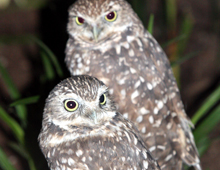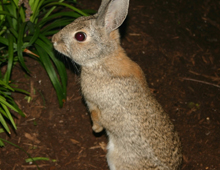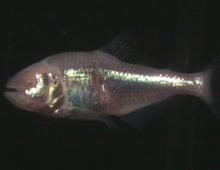Los Petenes

Burrowing owl, Athene cunicularia
Found all the way from the prairies of Southern Canada to Tierra del Fuego at the tip of South America, this is one of the most widespread birds of the New World. Throughout this vast range, it lives in holes in the ground. Though often awake in the daytime, its favorite times to hunt are dusk and dawn. Its prey is mostly insects and rodents. It thrives in captivity, and has bred at the DWA and in other collections. In mythology, owls were messengers of the Mayan Underworld, and companions of the Aztec Death God.
LEARN MORE
Desert cottontail, Sylvilagus audubonii
The 17 species of cottontails are entirely New World rabbits, in a different genus from domestic ones. They are distributed from Southern Canada to Northern Argentina. Eight are found in Mexico. This species, found in most of Mexico, as well as a large area of the western US, is named in honor of the famous bird painter, who also collected and painted many mammals. Cottontails make frequent appearances in the mythology and art of both the Mayans and Aztecs. In Mayan and Chinese tradition, a rabbit is the companion of the Moon Goddess.
LEARN MORE
Blind cavefish, Astyanax fasciatus mexicanus
When first discovered in the 1930s, these eyeless, pigmentless fish were assigned their own genus, Anoptichthys. Since then, ichthyologists have determined they are at least 30 genetically isolated populations of the Mexican tetra, which is normally a silvery fish with well-developed eyes that is found north to the Rio Grande Valley in Texas. Fish collected in one cave, la Cueva Chica, in San Luis Potosi in the 1940s, are the ancestors of the fishes made available by commercial breeders to home aquarists, public aquariums and zoos.
LEARN MORE

